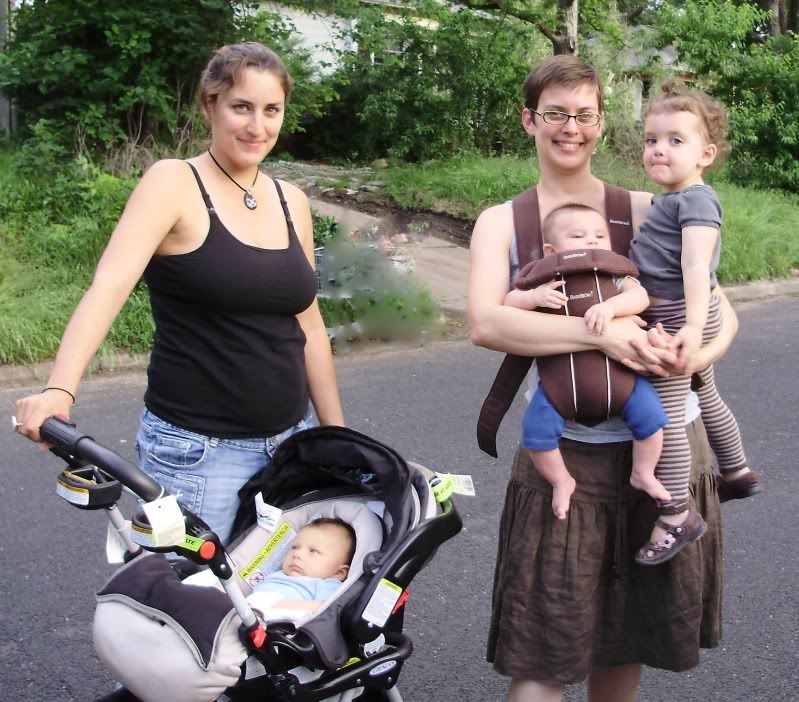Friday, May 28, 2010
Thursday, May 27, 2010
Wednesday, May 19, 2010
Cousins in Cali
Django visited his 2-month-old cousin Axel in San Diego last week. Behold the fun:
Django's gets his first view of the Pacific.
The boys get in a good workout in Axel's play gym.
"Psst - I think there are some seals behind us."
Skater hater:
Even cuter when squashed together:
Tandem spectating:
Pretty flowers:
Mr. Handsome puts on the charm.
Django's gets his first view of the Pacific.
The boys get in a good workout in Axel's play gym.
"Psst - I think there are some seals behind us."
Skater hater:
Even cuter when squashed together:
Tandem spectating:
Pretty flowers:
Mr. Handsome puts on the charm.
Thursday, May 06, 2010
We are all vapors.
That is, we all were and we all will be. Our very atoms assemble from vapors to give us life and disperse as vapors upon our deaths.
I drew this surprising conclusion from three seemingly disparate observations over the last three weeks:
1. I observed the death and cremation of a dear friend.
2. I watched (and smelled) the slow deterioration of a chicken corpse in the gutter down the street from my home.
3. I read and wrote about biogeochemical cycles for a work project.
At the risk of droning on and on about boring things, let me explain...
After a cremation, people usually cherish the ashes, but they are nothing in my mind. They are really only a fraction of the original material that made up the body. After burning, most of you enters the atmosphere. Here is a little chemistry lesson: Any living thing, whether a tree or a person, is composed mostly of water. After that we are mostly carbon- and hydrogen-containing molecules. Proteins, fats, carbohydrates—all these are large, twiggy clusters of carbon infused with sparse quantities of other elements such as nitrogen and oxygen. Each branching leg of these molecules is studded with tiny hydrogen atoms. Combustion (burning) is the combining of carbon and hydrogen atoms with oxygen. The products are water (H and O) and carbon dioxide (C and O) and a brilliant burst of flaming hot energy. Thus, if you burn something that was once alive—a log, a corpse—you are releasing gaseous carbon dioxide and vaporized water into the air, and generating a lot of heat. Ashes are the byproduct—the leftovers produced when there isn’t enough of one ingredient of the reaction or another to make the final product. It’s like buying too much flower and just enough eggs and sugar to make a bunch of cakes. In the end, you will have the cakes and a leftover pile of unused flour. That is ashes. I am of course more interested in the cakes. And these are what emanate from the cremation oven and pour into the blanket of gases we call the atmosphere.
And, don’t think that by having your corpse buried rather than cremated that you are evading this gassy fate. When your body rots, the little bugs and bacteria work busily away at your dead meat, producing—you guessed it—carbon dioxide and water. This water probably just seeps into the ground, and over time may transpire from plants or evaporate to become a gas, too. But, the carbon dioxide—it definitely goes straight into the vapor mix.
Until this month, I have had it all wrong in my brain. In my understanding of the Great Cycle of Life, I have always focused erroneously on the solids and ignored the vapors. I saw only the food chain, whereby an animal eats a plant, I eat the animal, the worms eat me and produce soil, and the plant grows from this soil. These are important steps, but they don’t account for the greater portion of my atoms.
So, to keep track of those dear atoms, don’t follow the ashes, follow the vapors—a much greater challenge because they are so evasive. We are made up of the carbon, oxygen, and hydrogen that became the gases that drifted away, swirling and mixing with the air around us. The water eventually condensed to form droplets that made up clouds. These clouds formed drops that rained to Earth, soaked into soil, and drew up through the roots of plants. The carbon dioxide too was taken up by plants, through their leaves. Here is a little biology lesson: Plants make carbohydrates (sugars) through a process called photosynthesis. They use the carbon dioxide and water and, fueled by the warming power of sunlight, combine these substances to form the food they need. People erroneously think that fertilizer is plant food, but really, it is more like a multivitamin—essential for the health and survival of the plant, but only a fraction of its actual sustenance. Plants make their own food from air and water. People eat plants (and animals that have eaten plants) to get at this food. This is essentially how it is that we come from the very vapors that are released by the burning and rotting of flesh.
This is why every day I will breathe more deeply to become evermore connected to everyone and every thing that has ever graced this Earth.
I drew this surprising conclusion from three seemingly disparate observations over the last three weeks:
1. I observed the death and cremation of a dear friend.
2. I watched (and smelled) the slow deterioration of a chicken corpse in the gutter down the street from my home.
3. I read and wrote about biogeochemical cycles for a work project.
At the risk of droning on and on about boring things, let me explain...
After a cremation, people usually cherish the ashes, but they are nothing in my mind. They are really only a fraction of the original material that made up the body. After burning, most of you enters the atmosphere. Here is a little chemistry lesson: Any living thing, whether a tree or a person, is composed mostly of water. After that we are mostly carbon- and hydrogen-containing molecules. Proteins, fats, carbohydrates—all these are large, twiggy clusters of carbon infused with sparse quantities of other elements such as nitrogen and oxygen. Each branching leg of these molecules is studded with tiny hydrogen atoms. Combustion (burning) is the combining of carbon and hydrogen atoms with oxygen. The products are water (H and O) and carbon dioxide (C and O) and a brilliant burst of flaming hot energy. Thus, if you burn something that was once alive—a log, a corpse—you are releasing gaseous carbon dioxide and vaporized water into the air, and generating a lot of heat. Ashes are the byproduct—the leftovers produced when there isn’t enough of one ingredient of the reaction or another to make the final product. It’s like buying too much flower and just enough eggs and sugar to make a bunch of cakes. In the end, you will have the cakes and a leftover pile of unused flour. That is ashes. I am of course more interested in the cakes. And these are what emanate from the cremation oven and pour into the blanket of gases we call the atmosphere.
And, don’t think that by having your corpse buried rather than cremated that you are evading this gassy fate. When your body rots, the little bugs and bacteria work busily away at your dead meat, producing—you guessed it—carbon dioxide and water. This water probably just seeps into the ground, and over time may transpire from plants or evaporate to become a gas, too. But, the carbon dioxide—it definitely goes straight into the vapor mix.
Until this month, I have had it all wrong in my brain. In my understanding of the Great Cycle of Life, I have always focused erroneously on the solids and ignored the vapors. I saw only the food chain, whereby an animal eats a plant, I eat the animal, the worms eat me and produce soil, and the plant grows from this soil. These are important steps, but they don’t account for the greater portion of my atoms.
So, to keep track of those dear atoms, don’t follow the ashes, follow the vapors—a much greater challenge because they are so evasive. We are made up of the carbon, oxygen, and hydrogen that became the gases that drifted away, swirling and mixing with the air around us. The water eventually condensed to form droplets that made up clouds. These clouds formed drops that rained to Earth, soaked into soil, and drew up through the roots of plants. The carbon dioxide too was taken up by plants, through their leaves. Here is a little biology lesson: Plants make carbohydrates (sugars) through a process called photosynthesis. They use the carbon dioxide and water and, fueled by the warming power of sunlight, combine these substances to form the food they need. People erroneously think that fertilizer is plant food, but really, it is more like a multivitamin—essential for the health and survival of the plant, but only a fraction of its actual sustenance. Plants make their own food from air and water. People eat plants (and animals that have eaten plants) to get at this food. This is essentially how it is that we come from the very vapors that are released by the burning and rotting of flesh.
This is why every day I will breathe more deeply to become evermore connected to everyone and every thing that has ever graced this Earth.
Wednesday, May 05, 2010
Denying
A person is so real that when she disappears, you cannot believe she is gone. In many ways, she is never gone. Her concept and influence remain with you always. But in all the important ways, she has evaporated. You will no longer cook together, work out together, argue, laugh, discuss. I witnessed this vaporization of my friend. I saw nearly all of the tiny steps that have led to the final realization of her passing. However, I cannot accept that she is gone.
To burn a body is to force yourself to accept that you cannot reanimate your loved one. Having witnessed the cremation, I can now understand that my friend’s life is unsalvageable. No miracle of science and medicine will bring her back to life. However, absence is not a very powerful proof of a concept. I may conceive of the loss of her, but I do not see it. There is no daily evidence that she won’t just show up at a party or text me or call to say hello. I went over to her house and her clothes are still there, clean, folded, waiting for her to fill them up with her living self. If we give them away, we are admitting that she will never need them again. If I remove her phone number from my cell phone directory, I am admitting I will never call her again. I am not ready to admit these things.
To burn a body is to force yourself to accept that you cannot reanimate your loved one. Having witnessed the cremation, I can now understand that my friend’s life is unsalvageable. No miracle of science and medicine will bring her back to life. However, absence is not a very powerful proof of a concept. I may conceive of the loss of her, but I do not see it. There is no daily evidence that she won’t just show up at a party or text me or call to say hello. I went over to her house and her clothes are still there, clean, folded, waiting for her to fill them up with her living self. If we give them away, we are admitting that she will never need them again. If I remove her phone number from my cell phone directory, I am admitting I will never call her again. I am not ready to admit these things.
Saturday, May 01, 2010
Subscribe to:
Posts (Atom)





















